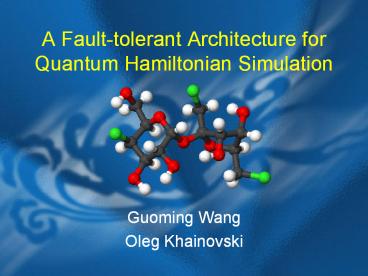A Fault-tolerant Architecture for Quantum Hamiltonian Simulation - PowerPoint PPT Presentation
1 / 26
Title:
A Fault-tolerant Architecture for Quantum Hamiltonian Simulation
Description:
Background Quantum Mechanical Systems are everywhere nuclear reaction, chemical molecules, superconductor, DNA, ..... ... Application: studying materials ... – PowerPoint PPT presentation
Number of Views:90
Avg rating:3.0/5.0
Title: A Fault-tolerant Architecture for Quantum Hamiltonian Simulation
1
A Fault-tolerant Architecture for Quantum
Hamiltonian Simulation
- Guoming Wang
- Oleg Khainovski
2
Background
- Quantum Mechanical Systems are everywhere
- nuclear reaction, chemical molecules,
superconductor, DNA, ...... - Quantum systems states are vectors of
exponential length in the number of particles it
contains - ? Large-scale quantum systems are hard to
simulate on classical computers - Quantum simulation is the original motivation for
building a quantum computer suggested by Richard
Feynman in 1982 - Efficient simulation of quantum systems is
perhaps the most important application of quantum
computers
3
Hamiltonian
- Shrödingers Equation
- H(t) -- Hamiltonian
- a matrix that represents total energy of the
system - usually a sum of local terms
2D Ising Model
4
Hamiltonian Simulation
- For time-independent Hamiltonian
- Time-independent Hamiltonian Simulation Problem
- Given the description of a Hamiltonian H and a
time t, build a polynomial-size quantum circuit
that approximates the unitary transformation
5
Quantum CAD Flow
6
Our Work
- Studied the architecture for Hamiltonian
Simulation using Quantum CAD flow - A software that, given a Hamiltonian Simulation
problem, generates and optimizes the solution
circuit, and then feeds it into the CAD flow - Optimizations to the Error Correction Synthesis,
Datapath Synthesis and Mapping stages of the CAD
flow
7
How to Simulate Hamiltonians
- Basic Principle
- Outline
8
How to Simulate Hamiltonians
- Each local term only acts on few number of
qubits, and can be implemented by a relatively
small circuit
Use Solovay-Kitaev algorithm to find a short
sequence of basic instructions
9
Optimization by Layering
- Observation
- The ordering of local terms affects the
parallelism of the resulting circuit - define layers of local terms --- all local
terms in the same layer are independent - Term-by-Term ? Layer-by-Layer
- use a greedy algorithm to find layers
10
Optimization by Layering
- Particularly good for Ising Model
- number of layers independent of number of qubits
11
Standard Error Correction
- Quantum Error Correction
- Two Stages
- Correct X (bit flip) error
- Correct Z (phase flip) error
- Standard Error Correction place correction after
every gate - too expensive (gt90 physical operations)
- more gates and movements ? more errors?
12
Selective Error Correction
- Selective Error Correction
- place fewer corrections on the Critical Error
Path - define an Error Distance Threshold
- CNOT propagates the input errors
- reduced gate count satisfactory success
probability
13
Selective XZ Error Correction
- Observation
- X (Bit flip) and Z (Phase flip) errors have
different behaviors - Correct them separately ? further reduce gate
count
14
Datapath Organizations
- Qalypso
- variable sized compute and memory regions,
ancilla generators, - teleportation network
- determined based on an analysis of the given
circuit or users - choice
15
Qalypso
- Idea reduce the number of expensive long-range
teleportation communications - analyze the given circuit, construct a graph
whose vertices are data qubits and edges are
their interactions - find a relatively small and balanced cut of this
graph - each part of data qubits are assigned to a
particular compute region as its favorite
qubits
16
Mapping
- For every gate in the program order, decide which
functional unit is used to execute it and hence
how to move the data qubits - evaluate every functional unit to find the best
- if a compute region does not like one of the
input qubits, then all the functional units it
contains will get a penalty - By this rule, every data qubit lives in a
particular compute region most of the time and
moves out only when necessary - This partitioning and mapping strategy is
particularly good for Hamiltonian Simulation
Circuits - particles normally interact only with its
neighbors
17
Metric for Probabilistic Computation
- Metric Area-Delay-to-Correct-Result (ADCR)
- For ADCR, lower is better.
18
Experimental Results
- Effect of Layering for Ising Model
19
Experimental Results
- Effect of Layering for General Hamiltonian
20
Experimental Results
- Comparison of Datapaths for General Hamiltonian
21
Experimental Results
- Comparison of Datapaths for Random Circuit
22
Experimental Results
- Comparison of Error Correction Schemes
23
Experimental Results
- Effect of Error Distance Threshold
24
Experimental Results
- Overall for General Hamiltonian
25
Experimental Results
- Overall for General Hamiltonian
26
Future Direction
- Further Improvement to Hamiltonian Simulation
- Better Layering?
- Better Partitioning and Mapping?
- Other aspects Routing? Ancilla factory?
- Extension to Time-dependent Hamiltonian
Simulation - Adiabatic algorithms?
- Application studying materials? solving linear
systems?































